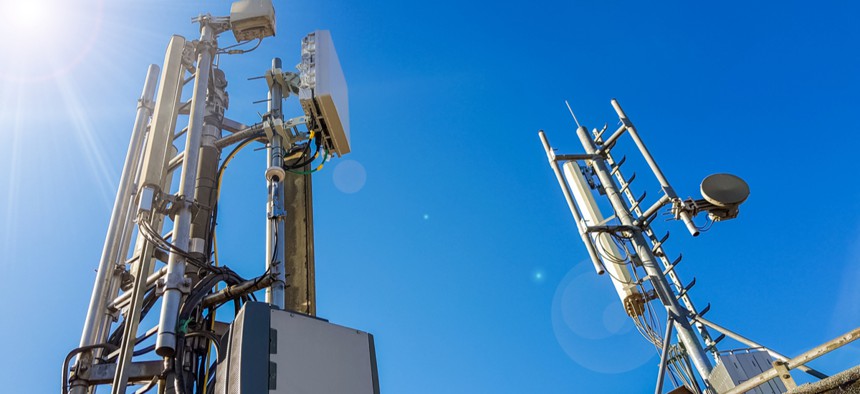Agencies Offer Sneak Peeks into Their 5G Plans

TPROduction/Shutterstock
From fixing planes before they break to doctors performing surgery in real time from two continents, agency officials are already looking at how faster connections could change their missions.
Fifth-generation wireless technology will disrupt the global mobile landscape and initiate unprecedented levels of human-device and device-device connectivity, federal officials and industry insiders said at the General Services Administration 5G symposium Thursday.
Gathered at GSA’s headquarters in Washington, agency leaders offered insights into their 5G vision and the adoption they’ve seen so far.
“5G will ignite a period of explosive, informative, unparalleled innovation in ways that health care is going to deliver,” Marc Wine, senior adviser at the Veterans Affairs Department said.
The speed of 5G connectivity will allow for precision surgery that’s down to the microsecond and augmented by holographic imaging, as well as accelerated and expanded health care training from the use of connected devices that enable virtual participative medical education, Wine said. It will also advance the agency’s current 3D printing implementations, which allow professionals to custom build medical pieces that specifically fit patients' needs, and can actually be connected to implantable devices in patients’ bodies.
4G connected everyone, but 5G will connect everything, meaning the new levels of connectivity will also open the door to security vulnerabilities. To support the preparation for an entirely new threat landscape, Wine recently helped develop a soon-to-be-published report on how to strengthen medical device cybersecurity across the health care ecosystem. The recommendations he produced offer insights on which medical devices should be trusted in the complex evolving environments, and which are most at risk of falling victim to harmful signals from malicious actors. “We can monitor that with a set of certain tools and we can prevent that,” Wine said.
Wine recently observed the use of augmented reality through which one physician in the United States was wearing “will-be 5G enabled” AR goggles and communicating live with a physician on the ground in the Middle East who was treating a wounded service member.
“They were working together in real time,” he said. “I became acutely aware of how virtual reality ... and other health information technology solutions enabled by 5G broadband in health care will advance, enhance, and innovate the tools and solutions that will help our consumers take charge of their own healthcare and wellness in advanced ways that will be seamless, less costly and more rapidly innovative, and in particularly, secure and trustworthy.”
The Air Force’s Chief Technology Officer Frank Konieczny was quick to chime in.
“You need a good secure line,” for precision medicine, he said.
Konieczny said his teams have been implementing augmented and virtual reality, which is or will be enabled by 5G, to modernize the training of Air Force personnel. The branch already initiated a long-term initiative to get 5G LTE out to all of its bases, with the expectation of deploying it to 20 or more next year.
“We are doing this as a mission-level exercise as opposed to anything else,” he said.
Konieczny emphasized that planes are becoming more and more intelligent—and also generating massive troves of data that have become difficult to keep up with. The Air Force has trouble striking or making use of so much data—but 5G offers new capabilities to extract and slice that data. Konieczny said he’s hopeful that 5G will allow the branch to break up a lot of its data, from internet of things devices to planes and everything else, slice it up, and apply information analysis or predictive maintenance activities to make even better use of it.
“I mean, we want to get to the point where we can predict if a plane is going to have a problem and make sure that a part arrives before the plane actually lands, to fix that problem,” he said.
And at the National Institute of Standards and Technology, officials are also hyper-focused on advancing cellular security to prepare for a 5G world. Cybersecurity Engineer Jeff Cichonski said he and other representatives from the agency actively attend meetings of the 3rd Generation Partnership Project, or 3GPP program, a body that’s specifically responsible for defining the cellular security standards of how LTE works and how 5G will work going forward. The fact that it will be such a global system means there are increasingly complex issues to address as the technology advances, he said.
“This network, when we get off planes in Asia, or Europe and South America and turn on our phones—it’s going to work,” he said. “So there has to be optional things in there to meet regulations around the world.”
The engineer added that he’s taking the information he gains from 3GPP back to NIST’s national cybersecurity center of excellence, which Konieczny said is in the early days of reviewing various 5G use cases across America’s federal landscape. Eventually, they plan to address the security requirements and capabilities that are needed to support the 5G future of interconnectivity, and beyond.
“This effort around 5G is looking at, first of all, what are some of the challenges, what’s different here, and what different solutions exist to address these challenges,” Konieczny said.
RELATED PODCAST






